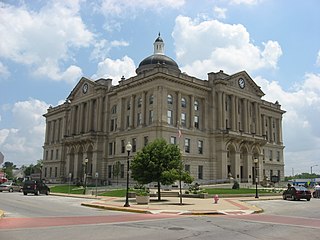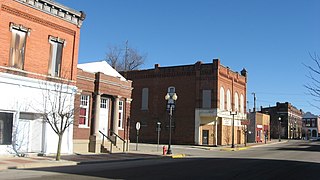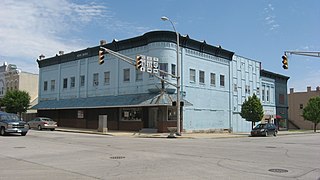
Columbus Historic District is a national historic district located at Columbus, Bartholomew County, Indiana. It encompasses 574 contributing buildings and 1 contributing sites in the central business district and surrounding residential areas of Columbus. It was developed between about 1850 and 1930, and includes notable examples of Federal and Italianate style architecture. A number of commercial buildings feature locally manufactured cast iron and pressed metal components. Located in the district are the separately listed Bartholomew County Courthouse, Columbus City Hall, and First Christian Church. Other notable buildings include the First National Bank, The Crump Theatre (1889), Reo Theater, Ulrich Bakery, Samuel Harris House (1853), Keller House (1860), Old Post Office (1910), Franklin Building, Gent Mill, First United Presbyterian Church (1871-1885), Irwin Block, Irwin Home and Gardens, and St. Batholomew's Roman Catholic Church (1891).

Point Historic District is a national historic district located at Logansport, Cass County, Indiana. The district encompasses 34 contributing buildings, 2 contributing sites, and 1 contributing structure in the heart of the oldest section of Logansport. It has a mix of residential and commercial buildings and notable examples of Queen Anne and Colonial Revival style residential architecture. Notable contributing resources include the Urban Point Park, Firestone Station (1928), All Saints Rectory, St. Joseph's Roman Catholic Church (1884), Geiger Building (1889), and St. Luke's English Evangelical Lutheran Church (1908).

Marion Downtown Commercial Historic District is a national historic district located at Marion, Grant County, Indiana. It encompasses 52 contributing buildings, 2 contributing structures, and 1 contributing object in the central business district of Marion. It developed between about 1870 and 1942, and includes notable examples of Italianate, Romanesque, and Classical Revival style architecture. Located in the district is the separately listed Grant County Jail and Sheriff's Residence. Other notable buildings are the Grant County Courthouse (1881-1883), Marion Bank Building, Iroquois Building, Dan-Mar Apartments, United Telephone Block, Cecelian Apartments, Marion Post Office, and William Smith Building / Mecca Club.

Baldwin Addition Historic District is a national historic district located at Fairmount, Grant County, Indiana. It encompasses 14 contributing buildings and 3 contributing structures in a predominantly residential section of Fairmount. It developed between about 1857 and 1930, and includes notable examples of Queen Anne and Greek Revival style architecture. Notable buildings include the Jonathan Baldwin House (1858), John Wilson Harvey houses, and the Gothic Revival style Fairmount Wesleyan Church (1916).

Noblesville Commercial Historic District is a national historic district located at Noblesville, Hamilton County, Indiana. It encompasses 54 contributing buildings in the central business district of Noblesville. It developed between about 1875 and 1931, and includes notable examples of Gothic Revival, Italianate, and Renaissance Revival style architecture. Located in the district is the separately listed Hamilton County Courthouse Square, which includes the courthouse (1877-1879) and Sheriff's Residence and Jail (1875). Other notable buildings include the Indiana Union Traction Company Station (1906), Lacy Block (1888), Evers Block (1889), U.S. Post Office (1906), U.S. Post Office (1931), and First Christian Church (1897-1898).

The Middletown Commercial Historic District is national historic district located at Middletown, Henry County, Indiana. It encompasses 17 contributing buildings in the central business district of Middletown. It developed between about the 1852 and 1916, and includes excellent examples of Italianate, Romanesque Revival, and Classical Revival styles of architecture. Notable buildings include the Hedrick Block, Hedrick Block (1880), Tykle Building (1873), Masonic Building (1899), Farmers State Bank (1914), Wisehart Building (1916), and Summers Building (1868).

Kokomo Courthouse Square Historic District is a national historic district located at Kokomo, Howard County, Indiana. The district includes 60 contributing buildings, 1 contributing structure, and 1 contributing object in the central business district of Kokomo. It developed between about 1870 and 1937 and includes notable examples of Italianate, Queen Anne, and Romanesque Revival style architecture. Notable buildings include the Draper Block (1904), Wilson Block, College Building (1909), Howard County Courthouse (1937), and a Railroad Watchman Tower.

Huntington Courthouse Square Historic District is a national historic district located at Huntington, Huntington County, Indiana. The district includes 102 contributing buildings and 3 contributing structures in the central business district of Huntington. It developed between about 1845 and 1942 and includes notable examples of Italianate, Queen Anne style architecture in the United States, Romanesque Revival, Neoclassical, and Commercial style architecture. Located in the district are the separately listed Moore/Carlew Building and Hotel LaFontaine. Other notable buildings include the Hotel Huntington (1848), Opera House (1881), Lewis Block, Huntington County Courthouse (1904), old Post Office (1916), Citizens' State Bank, City Hall / Fire Station (1904), Huntington Light and Fuel Building, Our Sunday Visitor building (1926), YMCA (1929), and Huntington Theater.

Seymour Commercial Historic District is a national historic district located at Seymour, Jackson County, Indiana. It encompasses 79 contributing buildings and 4 contributing structures in the central business district of Seymour. The district developed between about 1876 and 1945, and includes notable examples of Italianate, Romanesque Revival, and Classical Revival style architecture. Located in the district is the separately listed Farmers Club. Other notable buildings include the Masonic Temple (1901), Richart Block (1900), Steinker Meat Market, Seymour National Bank, Southern Indiana Telephone and Telegraph Building (1929), Jonas Hotel, and Kidd Saloon (1887).

Redkey Historic District is a national historic district located at Redkey, Jay County, Indiana. It encompasses 25 contributing buildings in the central business district of Redkey. The district developed between about 1888 and 1935, and includes notable examples of Italianate, Romanesque Revival, and Classical Revival style architecture. Notable buildings include the City Building (1905), Appenseller's Department Store (1906), K of P Building (1911), Farmers an Merchants First National Bank Building, Masonic Lodge, IOOF Building, Brown-Ellis Block (1888), and Cultice-Mann Block (1891).

Greenwood Commercial Historic District is a national historic district located at Greenwood, Johnson County, Indiana. The district encompasses 25 contributing buildings in the central business district of Greenwood. It developed between about 1860 and 1935, and includes notable examples of Italianate, Romanesque, and Classical Revival style architecture. Notable buildings include the Grafton Peek Building (1887), former Odd Fellows Hall, former Masonic Lodge (1909), G.W. Clemmons Block (1906), and the Interurban Public Service Company and Interurban Station.

Hobart Commercial District is a national historic district located at Hobart, Lake County, Indiana. The district encompasses 38 contributing buildings in the central business district of Hobart. It developed between about 1869 and 1963, and includes notable example of Italianate, Classical Revival, and Art Deco style architecture. Notable buildings include the Verplank Building (1928), Orcutt Hotel and Office / Mander Building (1915), Fiester Building (1907), Fiester Building (1890-1893), Hobart Bank, Art Theater, Ben Ack Building (1926), Hobart Post Office, Roper Building / American Bank and Trust, First State Bank, Lake George Hotel / Stocker Building, Schultz Brothers Variety Store (1947), and the Kostbase Building (1950).

Hohman Avenue Commercial Historic District is a national historic district located at Hammond, Lake County, Indiana. The district encompasses 15 contributing buildings in the central business district of Hammond. It developed between about 1904 and 1956, and includes notable example of Romanesque Revival, Classical Revival, and Colonial Revival style architecture. Notable buildings include Knott's Apartments (1904), Emmerling Ambulance Garage (1918), Emmerling Building (1918), St. Joseph's Roman Catholic Church Complex, LaSalle Hotel, OK Building (1913), and the Hammond National Bank.

Franklin Street Commercial Historic District is a national historic district located at Michigan City, LaPorte County, Indiana. The district encompasses 73 contributing buildings and 1 contributing object in the central business district and surrounding residential section of Michigan City. It developed between about 1875 and 1955, and includes examples of Italianate, Gothic Revival, Queen Anne, Classical Revival, and Tudor Revival style architecture. Located in the district is the separately listed Michigan City Post Office (1909-1910). Other notable buildings include the Staiger House, Earl House, M & M Diner (1955), Zorn Building (1907), St. Paul's Lutheran Church (1876) and rectory (1888), First Federal Savings Bank, Aicher Block (1914), Brinkman Building, Trinity Episcopal Church (1889), Merchants National Bank Building (1926), Ledbetter Building (1908), Rodenbeck Saloon, First Methodist Episcopal Church (1922), Barker Hall (1929), Masonic Temple (1922-1923), and the Salvation Army Building (1925).

Union City Commercial Historic District is a national historic district located at Union City, Randolph County, Indiana. The district encompasses 53 contributing buildings in the central business district of Union City. The district developed between about 1870 and 1948 and includes notable examples of Italianate and Romanesque Revival, style architecture. Located in the district is the separately listed Raphael Kirshbaum Building. Other notable buildings include the Jackson Building (1892), J.K. Building (1889), Grazhs Building (1893), and Union City Post Office (1935).

West Washington Historic District is a national historic district located at South Bend, St. Joseph County, Indiana. It encompasses 330 contributing buildings in an upper class residential section of South Bend. It developed between about 1854 and 1910, and includes notable examples of Italianate, Greek Revival, and Romanesque Revival style architecture. Located in the district are the separately listed Morey-Lampert House, Oliver Mansion designed by Lamb and Rich, Second St. Joseph County Courthouse, South Bend Remedy Company Building, and Tippecanoe Place. Other notable buildings include the Bartlett House (1850), Birdsell House (1897), DeRhodes House designed by Frank Lloyd Wright, Holley House, Kaiser-Schmidt House, Listenberger-Nemeth House, Meahger-Daughterty House (1884), O'Brien House, Oren House, The People's Church (1889), St. Hedwig's Church, St. Patrick's Church (1886), St. Paul's Memorial United Methodist Church (1901), West House, and a rwo of worker's house.

Shelbyville Commercial Historic District is a national historic district located at Shelbyville, Shelby County, Indiana. The district encompasses 149 contributing buildings, 1 contributing site, and 2 contributing objects in the central business district of Shelbyville. It developed between about 1822 and the 1930s, and includes notable examples of Italianate, Second Empire, Beaux-Arts, Classical Revival, and Art Deco style architecture. Notable contributing resources include the Shelbyville Central Schools Administrative Offices (1912), Carnegie Library (1902), First Baptist Church (1903), St. Joseph Catholic Church and School (1908), Civic Center (1932), Melton Jewelry Store (1886), Blessing-Deprez Building (1869), Knights of Pythias (1901), Cherry Building (1889), I.O.O.F. Building (1895), Old High School Building (1886), and a statue of Charles Major (1929).

Angola Commercial Historic District is a national historic district located at Angola, Steuben County, Indiana. The district encompasses 49 contributing buildings, 1 contributing site, and 2 contributing objects in the central business district of Shelbyville. It developed between about 1861 and the 1960, and includes notable examples of Italianate, Romanesque Revival, Beaux-Arts, Classical Revival, Late Gothic Revival, and Art Deco style architecture. Located in the district are the separately listed Steuben County Courthouse and Steuben County Jail. Other notable buildings include the Angola City Hall, Angola Police and Fire Department Building (1939), First Congregational United Church of Christ (1899), United Methodist Church of Angola (1889), Patterson Block (1861), Jackson Block (1870), Croxton Opera House (1892), Angola Masonic Building (1929), Armory Building (1916), and First National Bank (1923).

Downtown Wabash Historic District, also known as the Wabash Marketplace District, is a national historic district located at Wabash, Wabash County, Indiana. It encompasses 27 contributing buildings in the central business district of Wabash. It developed between about 1840 and 1920, and includes representative examples of Italianate, Romanesque Revival, and Second Empire style architecture. Located in the district are the separately listed James M. Amoss Building and Solomon Wilson Building. Other notable buildings include the E.M. Conner Building (1897), Back Saddlery and Harness Shop (1845), Wabash Loan and Trust Company (1927), Bradley Block (1901), Busick Block (1882), Eagles Building (1906), the Plain Dealer Building (1897), S.J. Payne Block (1898), J.C. Penney's (1920), National Block (1876), Sheriff's House and Jail (1879), Memorial Hall (1899), U.S. Post Office (1911-1912), Wabash County Courthouse (1878), Shively Block (1897), and Wabash City Hall (1883-1884).

Virginia Avenue District is a national historic district located at Indianapolis, Indiana. The district encompasses 43 contributing buildings and 1 contributing structure in the Fountain Square Commercial Areas of Indianapolis. It developed between about 1871 and 1932, and notable buildings include the Sanders (Apex) Theater (1913), Southside Wagon and Carriage Works / Saffel Chair Company, Fountain Square Theater (1928), Woessner Building, Granada Theater (1928), Southside Theater (1911), Schreiber Block (1895), Fountain Square State Bank (1922), and Fountain Bank (1902).























